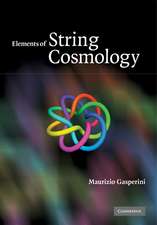Gravitational Lenses: Astronomy and Astrophysics Library
Autor P. Schneider, J. Ehlers, E.E. Falcoen Limba Engleză Paperback – 19 oct 1999
Din seria Astronomy and Astrophysics Library
- 19%
 Preț: 455.24 lei
Preț: 455.24 lei - 13%
 Preț: 393.37 lei
Preț: 393.37 lei - 15%
 Preț: 603.58 lei
Preț: 603.58 lei - 17%
 Preț: 496.37 lei
Preț: 496.37 lei - 15%
 Preț: 647.40 lei
Preț: 647.40 lei - 17%
 Preț: 525.72 lei
Preț: 525.72 lei - 17%
 Preț: 393.90 lei
Preț: 393.90 lei - 19%
 Preț: 524.14 lei
Preț: 524.14 lei - 15%
 Preț: 541.54 lei
Preț: 541.54 lei - 17%
 Preț: 362.70 lei
Preț: 362.70 lei - 15%
 Preț: 641.20 lei
Preț: 641.20 lei - 18%
 Preț: 745.33 lei
Preț: 745.33 lei - 18%
 Preț: 1006.55 lei
Preț: 1006.55 lei - 15%
 Preț: 598.21 lei
Preț: 598.21 lei -
 Preț: 397.38 lei
Preț: 397.38 lei - 15%
 Preț: 658.05 lei
Preț: 658.05 lei - 23%
 Preț: 815.07 lei
Preț: 815.07 lei -
 Preț: 409.89 lei
Preț: 409.89 lei - 15%
 Preț: 610.61 lei
Preț: 610.61 lei -
 Preț: 393.90 lei
Preț: 393.90 lei - 15%
 Preț: 655.27 lei
Preț: 655.27 lei - 18%
 Preț: 951.47 lei
Preț: 951.47 lei - 18%
 Preț: 960.42 lei
Preț: 960.42 lei - 18%
 Preț: 1397.68 lei
Preț: 1397.68 lei - 18%
 Preț: 959.98 lei
Preț: 959.98 lei - 15%
 Preț: 481.03 lei
Preț: 481.03 lei - 15%
 Preț: 672.43 lei
Preț: 672.43 lei - 18%
 Preț: 1012.08 lei
Preț: 1012.08 lei - 18%
 Preț: 1410.63 lei
Preț: 1410.63 lei -
 Preț: 390.08 lei
Preț: 390.08 lei - 18%
 Preț: 944.99 lei
Preț: 944.99 lei - 19%
 Preț: 502.94 lei
Preț: 502.94 lei - 15%
 Preț: 654.12 lei
Preț: 654.12 lei - 24%
 Preț: 851.62 lei
Preț: 851.62 lei - 19%
 Preț: 515.32 lei
Preț: 515.32 lei - 15%
 Preț: 663.14 lei
Preț: 663.14 lei - 15%
 Preț: 656.43 lei
Preț: 656.43 lei - 18%
 Preț: 741.68 lei
Preț: 741.68 lei - 15%
 Preț: 647.40 lei
Preț: 647.40 lei -
 Preț: 388.90 lei
Preț: 388.90 lei -
 Preț: 413.15 lei
Preț: 413.15 lei - 18%
 Preț: 1554.72 lei
Preț: 1554.72 lei - 18%
 Preț: 1223.11 lei
Preț: 1223.11 lei - 15%
 Preț: 651.51 lei
Preț: 651.51 lei - 15%
 Preț: 655.27 lei
Preț: 655.27 lei -
 Preț: 347.59 lei
Preț: 347.59 lei
Preț: 585.60 lei
Preț vechi: 732.00 lei
-20% Nou
Puncte Express: 878
Preț estimativ în valută:
112.07€ • 114.77$ • 93.22£
112.07€ • 114.77$ • 93.22£
Carte tipărită la comandă
Livrare economică 15-21 martie
Preluare comenzi: 021 569.72.76
Specificații
ISBN-13: 9783540665069
ISBN-10: 3540665064
Pagini: 574
Ilustrații: XIII, 560 p. 127 illus., 2 illus. in color.
Dimensiuni: 155 x 235 x 40 mm
Greutate: 0.82 kg
Ediția:1992
Editura: Springer Berlin, Heidelberg
Colecția Springer
Seria Astronomy and Astrophysics Library
Locul publicării:Berlin, Heidelberg, Germany
ISBN-10: 3540665064
Pagini: 574
Ilustrații: XIII, 560 p. 127 illus., 2 illus. in color.
Dimensiuni: 155 x 235 x 40 mm
Greutate: 0.82 kg
Ediția:1992
Editura: Springer Berlin, Heidelberg
Colecția Springer
Seria Astronomy and Astrophysics Library
Locul publicării:Berlin, Heidelberg, Germany
Public țintă
ResearchCuprins
1 Introduction.- 2 Basic facts and the observational situation.- 3 Optics in curved spacetime.- 4 Derivation of the lens equation.- 5 Properties of the lens mapping.- 6 Lensing near critical points.- 7 Wave optics in gravitational lensing.- 8 Simple lens models.- 9 Multiple light deflection.- 10 Numerical methods.- 11 Statistical gravitational lensing: General considerations.- 12 Statistical gravitational lensing: Applications.- 13 Gravitational lenses as astrophysical tools.- References.- Index of Individual Objects.
Textul de pe ultima copertă
Light observed from distant objects is found to be deflected by the gravitational field of massive objects near the line of sight - an effect predicted by Einstein in his first paper setting forth the general theory of relativity, and confirmed by Eddington soon afterwards. If the source of the light is sufficiently distant and bright, and if the intervening object is massive enough and near enough to the line of sight, the gravitational field acts like a lens, focusing the light and producing one or more bright images of the source. This book, by renowned researchers in the field, begins by discussing the basic physics behind gravitational lenses: the optics of curved space-time. It then derives the appropriate equations for predicting the properties of these lenses. In addition, it presents up-to-date observational evidence for gravitational lenses and describes the particular properties of the observed cases. The authors also discuss applications of the results to problems in cosmology
Caracteristici
This book describes comprehensively and in sufficient detail both the theory and observation of gravitational lensing An effect that is of growing importance for astronomical observations and cosmological modelling













